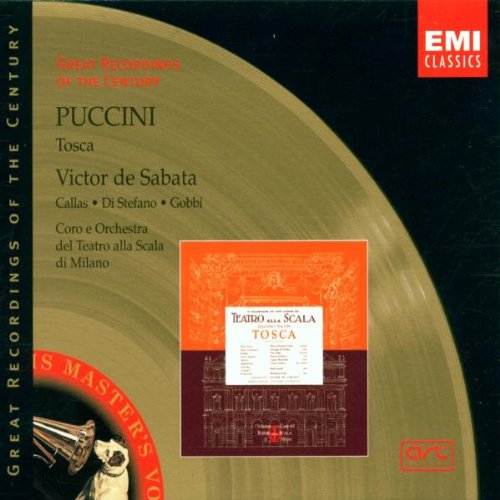Puccini Tosca
View record and artist detailsRecord and Artist Details
Composer or Director: Giacomo Puccini
Genre:
Opera
Label: EMI
Magazine Review Date: 9/1985
Media Format: CD or Download
Media Runtime: 108
Mastering:
Mono
ADD
Catalogue Number: 747175-8

Tracks:
| Composition | Artist Credit |
|---|---|
| Tosca |
Giacomo Puccini, Composer
Alvaro Cordova, Shepherd Boy, Treble/boy soprano Angelo Mercuriali, Spoletta, Tenor Dario Caselli, Gaoler, Baritone Dario Caselli, Sciarrone, Bass Dario Caselli, Gaoler, Bass Dario Caselli, Sciarrone, Baritone Dario Caselli, Gaoler, Baritone Dario Caselli, Sciarrone, Baritone Franco Calabrese, Angelotti, Bass Giacomo Puccini, Composer Giuseppe di Stefano, Cavaradossi, Tenor Maria Callas, Tosca, Soprano Melchiorre Luise, Sacristan, Bass Milan La Scala Chorus Milan La Scala Orchestra Tito Gobbi, Scarpia, Baritone Victor de Sabata, Conductor |
Author: Edward Greenfield
In the many hours of discussion I had over the years with the late Walter Legge, he would quite often question the necessity of stereo. Now more strikingly than ever in this digital remastering of one of the great classic performances of the gramophone, one of his own masterpieces as a creative recording producer, I can see what he meant. With offstage effects for example—so important in Puccini—precisely placed, there is a sense of presence normally reserved for twin-channel reproduction. In the long duet between Tosca and Cavaradossi in Act 3 I even detect a difference of placing between the two singers, Callas set at a slight distance, though whether or not to offset a microphone problem with so biting a voice one can only guess. The immediacy is astonishing, and the great moment of the execution with trombones rasping and the fusillade reproduced at a true fortissimo has never been represented on record with greater impact.
What especially delights me is that where on most previous CD transfers of mono originals the results have emphasized the single-channel flatness, often with sound lacking in body, this is full and weighty. A satisfyingly strong but not boomy bass, balances the extra brightness and clarity introduced in the treble. The slightly jangling brightness on some percussion instruments gives some hint of the age of the recording, but with mono of this vintage it is amazing what bloom there is even on the violins, and when it comes to the voices, there one simply forgets the years, and drinks in the glory of one of the really great recorded opera performances as never before. Apart from Legge's skills we must not forget Robert Beckett, the original engineer, and Christopher Parker who was responsible for the digital remastering.
The contrasts of timbre are beautifully brought out—amazingly wide with Gobbi as with Callas and with di Stefano producing his most honeyed tones. Though in the Milan acoustic there is less space than we have grown used to in the age of stereo, the separation of voices and orchestra is excellent, with the strands of the accompaniment to ''Vissi d'arte'', for example, finely clarified. Only in the big Te Deum scene at the end of Act 1 do I find a hint of overloading.
Wonderful as Gobbi's and di Stefano's performances are, and superbly dramatic as de Sabata's conducting is, it is the performance of the unique Callas in the title role that provides the greatest marvel, and here more than ever one registers the facial changes implied in each phrase, with occasional hints of a chuckle (usually ironic) more apparent than I had remembered. I only wish that EMI had provided many more bands instead of relying on just a few index points and only bands for the separate acts. For such a performance everything is worth it.'
What especially delights me is that where on most previous CD transfers of mono originals the results have emphasized the single-channel flatness, often with sound lacking in body, this is full and weighty. A satisfyingly strong but not boomy bass, balances the extra brightness and clarity introduced in the treble. The slightly jangling brightness on some percussion instruments gives some hint of the age of the recording, but with mono of this vintage it is amazing what bloom there is even on the violins, and when it comes to the voices, there one simply forgets the years, and drinks in the glory of one of the really great recorded opera performances as never before. Apart from Legge's skills we must not forget Robert Beckett, the original engineer, and Christopher Parker who was responsible for the digital remastering.
The contrasts of timbre are beautifully brought out—amazingly wide with Gobbi as with Callas and with di Stefano producing his most honeyed tones. Though in the Milan acoustic there is less space than we have grown used to in the age of stereo, the separation of voices and orchestra is excellent, with the strands of the accompaniment to ''Vissi d'arte'', for example, finely clarified. Only in the big Te Deum scene at the end of Act 1 do I find a hint of overloading.
Wonderful as Gobbi's and di Stefano's performances are, and superbly dramatic as de Sabata's conducting is, it is the performance of the unique Callas in the title role that provides the greatest marvel, and here more than ever one registers the facial changes implied in each phrase, with occasional hints of a chuckle (usually ironic) more apparent than I had remembered. I only wish that EMI had provided many more bands instead of relying on just a few index points and only bands for the separate acts. For such a performance everything is worth it.'
Discover the world's largest classical music catalogue with Presto Music.

Gramophone Digital Club
- Digital Edition
- Digital Archive
- Reviews Database
- Full website access
From £8.75 / month
Subscribe
Gramophone Full Club
- Print Edition
- Digital Edition
- Digital Archive
- Reviews Database
- Full website access
From £11.00 / month
Subscribe
If you are a library, university or other organisation that would be interested in an institutional subscription to Gramophone please click here for further information.




